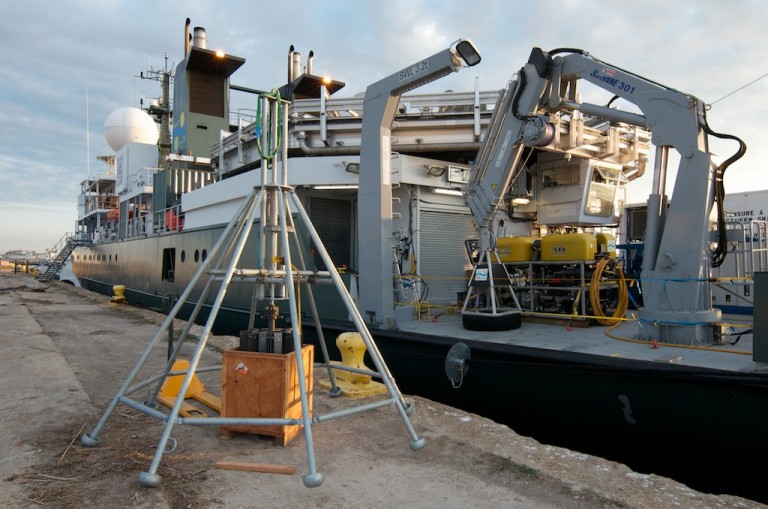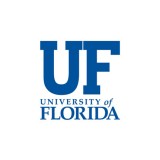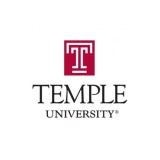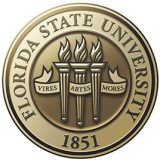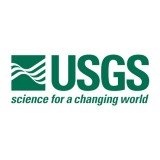This final shakedown cruise for the Schmidt Ocean Institute research vessel Falkor was dedicated to a comprehensive study of ecosystems near the site of Deepwater Horizon oil spill in the northern Gulf of Mexico.
This cruise was planned as the most intensive operational test of R/V Falkor and her embedded systems in advance of the committed research projects that started in 2013. This cruise spanned more than three weeks at sea and included high-resolution mapping of the seafloor for background data and scientific sampling decisions, remotely operated vehicle (ROV) operations, coordinated ROV operations with another research vessel during the mission, small plane overflight, numerous deployments of customized instruments brought by the science team, and round-the-clock experiments at sea in the onboard laboratories.
The November timing of the expedition added another test dimension for ship operations due to the potential for inclement weather heading into the winter season. Experience with sea state conditions has been essential training for R/V Falkor’s integrated operations. For example, it may take one to two hours to recover an ROV in the event of worsening weather, but the ship must still be able to maintain its position.
The expedition was a collaboration of Schmidt Ocean Institute with a multidisciplinary research program that was studying environmentally important questions about the impacts of oil on ocean ecosystems. Led by Dr. Ray Highsmith, the Ecosystem Impacts of Oil and Gas Inputs to the Gulf (ECOGIG) consortium brought together oceanographers, biologists and chemists from more than 17 institutions to study ecosystem impacts of natural oil and gas seepage versus that of oil disasters. The research investigated the long-term effects and ecosystem recovery from the Deepwater Horizon oil spill that occurred in April 2010. ECOGIG was funded by the Gulf of Mexico Research Initiative.
The scientists aboard R/V Falkor used cutting-edge sensors and an array of technical equipment to sample and monitor ECOGIG study sites. An important capability of R/V Falkor for this study was the deep-sea ROV Global Explorer MK3 that can operate to depths of 2,000 meters. The ROV was used to transport customized instruments to the seafloor and install them in precise locations with a dexterous manipulator arm. It is equipped with customized cameras, including an advanced 3-D video imaging system, that will give the scientists an unprecedented view of the seafloor around the study sites. Samples can be tracked to specific locations on the seafloor with high-quality navigation data from the ROV and ship.
Scientific Objectives
The first leg of the expedition, led by Chief Scientist Ian MacDonald from Florida State University, consisted of twelve scientists and graduate students from eight different institutions. A primary objective was to recover seafloor “lander” platforms that enable long-term studies of the microbial degradation of oil on the seafloor, and monitoring the flow of methane gas from the seafloor. Microbiologist Beth Orcutt of Bigelow Laboratory for Ocean Sciences led the lander operations.
The science team focused their studies on three areas: a deep-sea coral community; a site near the Macondo wellhead where a lander is currently deployed; and a natural hydrocarbon seep. Over the first two weeks, the team worked to:
- recover and redeploy benthic landers at two sites;
- collect water and coral samples with the ROV;
- collect sediment cores with the ROV and a multiple corer;
- deploy and recover short-term observing instruments; and
- conduct acoustic bathymetric and water column surveys.
The cores would be analyzed for hydrocarbon content and fingerprinting for presence of Macondo oil, microbial community structure, activity, and impact on sediment geochemistry, and evidence of gas hydrates. At hard grounds, the coral/bivalve community were investigated. An ECOGIG team aboard the research vessel R/VPelican linked up with R/V Falkor for the lander operations. And there was an overflight by an aircraft operated by On Wings of Care to record aerial photography of surface oil slicks. On November 19th, there was an exchange of research teams on board. The second leg, led by Chief Scientist Charles Fisher of Penn State University, focused on deep-sea coral studies.
by Debbie Nail Meyer
Data & Publications
All ECOGIG project data are submitted to GRIIDC – The Gulf of Mexico Research Initiative Information and Data Cooperative at the Harte Institute for Gulf of Mexico Studies.
Physiology and toxicology data from studies of coral exposed to oil and dispersant, laboratory experiment with samples collected during the cruise can be downloaded here.
- Cruise Report: Long-term Effect of the Deepwater Horizon Oil Spill - Leg 1
- Cruise Report: Long-term Effects of the Deepwater Horizon Oil Spill - Leg 2
- Cardona, Y., Ruiz,D., Baums, I.B., and A. Bracco. (2015). Potential Connectivity of Coldwater Black Coral Communities in the Northern Gulf of Mexico. XVI Congresso Latino Americano De Ciencias Del Mar- Colacmar y XVI Seminario Nacional de Ciencias y Tecnologias del mar, Santa Marta, Colombia.
- Dannenberg, R., Baums, I., Ruiz, D., and C. Fisher. (2015). Deep Sea Coral-associated Bacterial Community Composition Analysis Using 16S rDNA. 2015 Gulf of Mexico Oil Spill & Ecosystem Science Conference, Houston, TX, USA.
- DeLeo, D.M., Ruiz-Ramos, D., Baums I.B., and E.E. Cordes. (2015). Response of Deep-water Corals to Oil and Chemical Dispersant Exposure. Deep Sea Research II. DOI: 10.1016/j.dsr2.2015.02.028.
- Fisher, C. (2015) Mechanisms of impact from the Deepwater Horizon oil spill to corals and associated communities in the deep Gulf of Mexico. Gulf of Mexico Oil Spill and Ecosystem Science Conference. Houston TX.
- Fisher, C. (2015) Covered with Oil in the Ivory Tower. University of South Florida. Tampa FL.
- Fisher, C. (2015) Anthropogenic impact to the Earth’s final frontier. Rochester Institute of Technology. Rochester, NY.
- Garcia Pineda, O. M., Macdonald, I.R., Silva, M., Shedd, W., Daneshgar Asl, S., and B. Schumaker. (2015). Transience and Persistence of Natural Hydrocarbon Seepage in Mississippi Canyon, Gulf of Mexico Deep Sea Research Part II: Topical Studies in Oceanography, Deepwater Horizon Special Issue.
- Joye, S.B. (2015). Dispersant Impacts on Microbial Community Evolution and Activity in the Gulf of Mexico Deepwater. Guest Lecturer, University of Georgia School of Public Health, Athens, Georgia, USA.
- Ruiz-Ramos, D.V., Saunders, M., Fisher, C.R., and I.B. Baums. (2015). Home Bodies and Wanderers: Sympatric Lineages of the Deep-sea Black Coral Leiopathes glaberrima. PLos ONE 2015, 10(10):e0138989.
- Ziervogel, K., Dike, C., Asper, V., Montoya, J., Battles, J., D’souza, N., Passow, U., Diercks, A., Esch, M., Joye, S., Dewald, C., and C. Arnosti. (2015). Enhanced Particle Fluxes and Heterotrophic Bacterial Activities in the Gulf of Mexico Bottom Waters Following Storm-Induced Sediment Resuspension. Deep Sea Research Part II: Topical Studies in Oceanography. DOI: 10.1016/j.dsr2.2015.06.017.
- Girard, F., S. P. Berlet, C. Fisher. (2015) Understanding the impact of the Deepwater Horizon oil spill on coral communities in the deep Gulf of Mexico: The importance of symbiosis. Gulf of Mexico Oil Spill and Ecosystem Science Conference. Houston TX.
- Johansen, C., A. C. Todd, M. Silva, W. Shedd, and I. R. MacDonald (2015), Variability and quantification of oil and gas bubble release from natural seeps in the Gulf of Mexico (Oral Presentation), in Gulf of Mexico Oil Spill & Ecosystem Science Conference, edited, Houston, TX.
- Cordes, EE (2014) How Human Impacts Precede Human Presence: Oil spills and ocean acidification threaten deep-water corals in the Gulf of Mexico. Villanova University, Villanova, PA.
- Cordes EE (2014) Use of genetic tools to monitor populations of Paramuricea, a genus of deep-sea gorgonian corals impacted during the 2010 oil spill. Gulf of Mexico Oil Spill & Ecosystem Science Conference. Mobile, AL.
- Daneshgar Asl, S., J. Amos, P. Woods, O. Carcia Pineda, & I.R. MacDonald. (2014). Aerial survey validation of satellite SAR monitoring of anthropogenic hydrocarbon discharges in the Gulf of Mexico (Poster Presentation).Gulf of Mexico Oil Spill & Ecosystem Science Conference. Mobile, AL.
- Fisher, C. (2013). Impact to deep-water corals from the Deepwater Horizon Disaster. Gulf of Mexico Oil Spill and Ecosystem Science Conference. New Orleans, LA.
- Fisher, C. (2014). Footprint of impact from the Deepwater Horizon Incident. Gulf of Mexico Ecosystem Research Conference. Mobile, AL.
- Garcia-Pineda, O., I. MacDonald, & W. Shedd. (2014). Analysis of Oil-Volume Fluxes of Hydrocarbon-Seep Formations on the Green Canyon and Mississippi Canyon: A Study With 3D-Seismic Attributes in Combination With Satellite and Acoustic Data. Spe Reservoir Evaluation & Engineering 17(4): 430-435.
- Johansen, C., A. C. Todd, and I. R. MacDonald (2014), Quantifying the volume and frequency of bubble release from hydrocarbon seeps in the Gulf of Mexico (Oral Presentation) in 5th Early Career Scientists Conference for Marine and Climate Research, edited, Bremen, Germany.
- Johansen, C., A.C Todd, W. Dewar, W. Shedd, & I.R. MacDonald. (2014). Quantifying the volume and frequency of bubble release from hydrocarbon seeps in the Gulf of Mexico: GC600 (Poster Presentation). Gulf of Mexico Oil Spill & Ecosystem Science Conference, Mobile, AL.
- Young, D. & E.E. Cordes. (2014). Response of deep-water corals to oil and dispersant exposure. Presentation for the 2014 Gulf of Mexico Oil Spill and Ecosystem Science Conference. Mobile, AL.
- Baums, I.B. & D. Ruiz. (2013). The use of -omics to detect environmental stress in the Cnidaria. Gulf of Mexico Oil Spill & Ecosystem Science Conference. New Orleans, LA.
- Cordes EE (2013) Oral Presentation. Sensitivity and resilience of the deep-sea gorgonian coral Paramuricea sp. to oil and dispersant exposure. Gulf of Mexico Oil Spill & Ecosystem Science Conference. New Orleans, LA.
- Fisher, C (2014). Corals as deep-water sentinels of anthropogenic impact: Lessons from the Deepwater Horizon oil spill. Tech Week: Deep Blue Days, Brest, France.
- Lapham, L., B.Orcutt, P.Girguis, G.Wheat, & ECOGIG lander team. (2013). Deep-water sediment biogeochemical time-series data from MIMOSA (MIcrobial Methane Observatory for Seafloor Analysis). Gulf of Mexico Oil Spill and Ecosystem Conference, New Orleans, LA.
- Martens, C. (2013). The first benthic boundary layer water chemistry data from initial test deployments of the ROVARD-Chimney Sampler Array (CSA) at station MC-118 at 900 meters depth in the northern Gulf of Mexico.AGU Meeting, San Francisco, CA.
- Ruiz-Ramos D.V. & I.B. Baums. (2013). Impact of hydrocarbon/dispersant exposure on deep-water corals: the transcriptome of Leiopathes glaberrima. Gulf of Mexico Oil Spill & Ecosystem Science Conference, New Orleans, LA.
- Slattery, M., S. Ankisetty, D. Ruiz, & I.B. Baums. (2013). Optimization of proteomic profiling in the deep sea black coral, Leiopathes glaberrima. Gulf of Mexico Oil Spill & Ecosystem Science Conference, New Orleans, LA.
- Young, D. & E.E. Cordes. (2013). Stress responses of deep-sea corals to oil and dispersant exposure in the Gulf of Mexico. Presentation for the 42nd Benthic Ecology Meeting. Savannah, GA.
- Cordes EE (2015) Understanding the Deep Sea in the Anthropocene: Oil spills and ocean acidification threaten deep-water corals in the Gulf of Mexico. Lamont-Doherty Earth Observatory, Columbia University, Palisades NY.
- Fisher, C. (2012). Impact to deepwater coral gardens from the Deep Water Horizon disaster. Plenary presentation at the 13th International Deep-Sea Biology Symposium, Wellington, New Zealand.
- Joye, S.B. (2015). Spatial and Temporal Patterns in Microbial Communities Resulting from the Macondo Discharge. Appl. Envr. Microbiology Gordon Conference, South Hadley, Massachusetts, USA.
- MacDonald, I., C. Johansen, M. Silva, O. M. Garcia Pineda, and W. Shedd (2014), Short- and Long-Term Dynamics of Gas Hydrate at GC600: A Gulf of Mexico Hydrocarbon Seep, edited, in AGU Fall Meeting, San Francisco, CA.
- Fisher, C (2014). The deep water coral record of the Deepwater Horizon spill. Earth Talks, Penn State University, PA.
- Fisher, C (2014). Impact of oil pollution from the Deepwater Horizon spill on deep water ecosystems. Norwegian Ecotoxicology Symposium, Stavanger, Norway.
- Cordes EE (2014) Impacts of the Deepwater Horizon on Deepwater Corals. Gulf of Mexico Oil Spill & Ecosystem Science Conference. Mobile, AL.
- Daneshgar Asl, S., J.F., Woods, P., Garcia-Pineda, O., and I. R. MacDonald. (2014). Chronic, Anthropogenic, Hydrocarbon Discharges in the Gulf of Mexico. Deep Sea Research Part II: Topical Studies in Oceanography. doi: 10.1016/j.dsr2.2014.12.010.
- Fisher, C. (2013). The human factor: Our impact on the Earth’s final frontier. Sea Secrets (a public lecture series), University of Miami, Miami, FL.
- Ruiz-Ramos, D.V. & I.B. Baums. (2013). Impact of crude oil on the deep-water coral Leiopathes glaberrima. 11th Ecological Genomics Symposium, Kansas City, Missouri.
- Ruiz-Ramos, D.V. & I.B. Baums. (2012). Impact of hydrocarbon/dispersant exposure on deep-water corals: the transcriptome of Leiopathes glaberrima. 10th Anniversary Ecological Genomics Symposium, Kansas City, Missouri,
- Johansen, C., W. Shedd , T. Abichou, O. Pineda-Garcia, M. Silva, & I.R. MacDonald. (2012). Dynamics of Hydrocarbon Vents: Focus on Primary Porosity (Poster Presentation) AGU Fall Meeting, San Francisco, CA.
- Kleindienst, S., Grim, S., Sogin, M., Crespo-Medina, M., and S.B. Joye. (2016). The Response of Diverse Low-abundance Bacteria to a Deep-sea Hydrocarbon Plume. The ISME Journal, 10, 400-415. DOI: 10.1038/ismej.2015.121. [This publication is OPEN ACCESS.]
- Girard, F., Fu, B., and C. R. Fisher. (2016). Mutualistic symbiosis with ophiuroids limited the impact of the Deepwater Horizon oil spill on deep-sea octocorals. Marine Ecology Progress Series. 549: 89-98. doi:10.3354/meps11697 [This publication is OPEN ACCESS distributed under the terms of Creative Commons].
- Girard, F., Fu, B., Boyer, T., Curtis, C., and Fisher, C. (2016). Using image-based long-term monitoring to understand the biology and recovery of deep-sea coral communities after the Deepwater Horizon oil spill. Oral Presentation, 6th International Symposium on Deep-sea Corals, Boston, MA, USA.
- Orcutt B., Lapham L., Delaney J., Sarode N., Marshall K., Whaley-Martin K., Slater G., Wheat C., and P. Girguis. (2017). Microbial Response to Oil Enrichment in Gulf of Mexico Sediment Measured Using a Novel Long-term Benthic Lander System. Elementa Science of the Anthropocene, 5(18), doi:10.1525/elementa.129. [This article has been published as OPEN ACCESS.]
- Peña-Montenegro, T., Kleindienst, S., Allen, A., Eren, A., McCrow, J., Arnold, J., Joy, S. (2024). Metatranscriptomic response of deep ocean microbial populations to infusions of oil and/or synthetic chemical dispersant. Appl. Env. Microbiology, doi: 10.1128/aem.01083-24. [This article is OPEN ACCESS].
In the News
Scientists to Revisit Wellhead Site in Legendary Research Submarine
Gulf of Mexico Research Initiative • March 20th, 2014
Research Footprint Growing in the Gulf of Mexico
Gulf of Mexico Research Initiative • March 10th, 2014
Scientists get free use of research vessel to study BP oil disaster
WLOX • November 5th, 2012
New oil sheen prompts another investigation of BP Deepwater Horizon disaster scene
NOLA • November 14th, 2012
Coast Guard approves underwater inspection of BP well, Deepwater Horizon wreckage for oil
NOLA • November 29th, 2012
BP, Coast Guard say 4-day inspection of Macondo well, Deepwater Horizon debris turns up no oil
NOLA • December 18th, 2012

